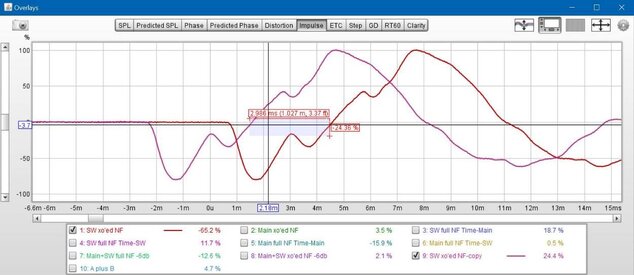r0b
Registered
Thread Starter
- Joined
- Mar 4, 2019
- Posts
- 3
More
- Preamp, Processor or Receiver
- Denon AVR-3311 + Monacor DSM-260 Speaker Managemen
- Main Amp
- Philips DFR 9000 ( The cheapest 6 UcD channels)
- Front Speakers
- Visaton Studio 2 + GF200 sub stands
- Center Channel Speaker
- Visaton Studio 2
- Surround Speakers
- Visaton AL130 + G20SC wall speakers
- Other Speakers
- Rasperry Pi 2 with OSMC for streaming
tl;dr:
Is there a way to band-limit the acoustic timing reference e.g. to 80-120 Hz so the data makes (relative) sense when crossing a sub to the mains?
Hi there,
quick Intro first:
my name is Robin. I'm from Germany and I was bit by the HiFi bug 20 years back, when an old car battery, car radio and speakers found on the street mounted on a cart were the equivalent of today's bluetooth speaker. Over the years lots of stuff passed though the living rooms. Recently I finished building some new Visaton Studio 2 speakers for my L-C-Rs. L and R are standing each on a side-firing subwoofer equipped with a Visaton GF200 (Visaton btw. has a superb customer service, so I stuck with them after outfitting my third portable speaker with Visaton speakers I bought in our local electronics shop).
Picture attached, room is acoustically rather friendly. LP is free roughly on the apex of an equilateral triangle.
Current situation:
The Studios (passive XO) and the subwoofers are xo'ed with a Monacor DSM 260 digital speaker management system (2 in / 6 out, equivalent to Behringer DCX 2496 at a different quality level). XO point is LR12 db @ 130 Hz for both systems. All is driven by a 6-channel Philips DFR 9000 AVR(Studios bi-amped, woofers direct). Now I am working on the time and phase alignment of woofer to midrange. Yesterday I spent two hours measuring (UMIK-1 available) and getting so frustrated I didn't even save the measurements anymore (a fact I do regret a bit now). There was just no winning in terms of figuring out the phase or even the timing delay between the two sources. Having the woofers sideways doesn't necessarily make it all easier. For example I took measurements at the listening position equally distanced from R and L mains. I measured left subwoofer with left main as timing reference (possible with routing in the DSM) and the same thing of the right. One side says 7 meter delay, the other 3,5 meter or so (physical distance maybe 30 cm). Just all seemed pretty random.
My problem:
I spent about 3-4 hours reasearching every note and thread here, on hts, on avsforums, on german forums concerning time alignment of subwoofers. I failed to find the one concrete tip in evaluating the band-limited impulse response that I get from my subwoofers with respect to my full range sharp peaked mains impulse response.
- I get why acoustic timing is necessary for the UMIK-1.
- I get why it doesn't work with the band limited sub.
- I think I get that I actually need to have the xo's set in the DSM to measure the phase, because otherwise it doesn't make sense.
- I don't necessarily get frequency dependent windowing, but have a feeling near-field measuring and FDW might get me closer (measurement position on straight line from my ears to between mains and midwoofer?).
- I DON'T get how to extract timing or phase information from my system.
- Group-Delay plot? ETC plot? Can't figure out what to make of them, although I read a PDF suggesting using that for alignment.
- Am I on the wrong path asking for a band-limited acoustic timing?
Pointers to any helping threads are very welcome, and I don't fear reading thorugh pages of technical disussions. Trust me though when I say I did google and read at least 5 or 6 detailed walkthrough PDFs/posts concerning Subwoofer alignment (including the ones linkes in the REW intro pdf).
I feel a bit bad for putting out such a long text and I hope it's still concise enough, but I do have the feeling that this here is the playe where I am closest toan answer.
Thanks for reading anyway!
Regards,
Robin
P.S.: I guess this thread is somewhat less useful without measurements. I'll try to get some done these next few days to discuss. Maybe just a pointer as to setup and what to measure will already be enough to get me on the right track ...
Is there a way to band-limit the acoustic timing reference e.g. to 80-120 Hz so the data makes (relative) sense when crossing a sub to the mains?
Hi there,
quick Intro first:
my name is Robin. I'm from Germany and I was bit by the HiFi bug 20 years back, when an old car battery, car radio and speakers found on the street mounted on a cart were the equivalent of today's bluetooth speaker. Over the years lots of stuff passed though the living rooms. Recently I finished building some new Visaton Studio 2 speakers for my L-C-Rs. L and R are standing each on a side-firing subwoofer equipped with a Visaton GF200 (Visaton btw. has a superb customer service, so I stuck with them after outfitting my third portable speaker with Visaton speakers I bought in our local electronics shop).
Picture attached, room is acoustically rather friendly. LP is free roughly on the apex of an equilateral triangle.
Current situation:
The Studios (passive XO) and the subwoofers are xo'ed with a Monacor DSM 260 digital speaker management system (2 in / 6 out, equivalent to Behringer DCX 2496 at a different quality level). XO point is LR12 db @ 130 Hz for both systems. All is driven by a 6-channel Philips DFR 9000 AVR(Studios bi-amped, woofers direct). Now I am working on the time and phase alignment of woofer to midrange. Yesterday I spent two hours measuring (UMIK-1 available) and getting so frustrated I didn't even save the measurements anymore (a fact I do regret a bit now). There was just no winning in terms of figuring out the phase or even the timing delay between the two sources. Having the woofers sideways doesn't necessarily make it all easier. For example I took measurements at the listening position equally distanced from R and L mains. I measured left subwoofer with left main as timing reference (possible with routing in the DSM) and the same thing of the right. One side says 7 meter delay, the other 3,5 meter or so (physical distance maybe 30 cm). Just all seemed pretty random.
My problem:
I spent about 3-4 hours reasearching every note and thread here, on hts, on avsforums, on german forums concerning time alignment of subwoofers. I failed to find the one concrete tip in evaluating the band-limited impulse response that I get from my subwoofers with respect to my full range sharp peaked mains impulse response.
- I get why acoustic timing is necessary for the UMIK-1.
- I get why it doesn't work with the band limited sub.
- I think I get that I actually need to have the xo's set in the DSM to measure the phase, because otherwise it doesn't make sense.
- I don't necessarily get frequency dependent windowing, but have a feeling near-field measuring and FDW might get me closer (measurement position on straight line from my ears to between mains and midwoofer?).
- I DON'T get how to extract timing or phase information from my system.
- Group-Delay plot? ETC plot? Can't figure out what to make of them, although I read a PDF suggesting using that for alignment.
- Am I on the wrong path asking for a band-limited acoustic timing?
Pointers to any helping threads are very welcome, and I don't fear reading thorugh pages of technical disussions. Trust me though when I say I did google and read at least 5 or 6 detailed walkthrough PDFs/posts concerning Subwoofer alignment (including the ones linkes in the REW intro pdf).
I feel a bit bad for putting out such a long text and I hope it's still concise enough, but I do have the feeling that this here is the playe where I am closest toan answer.
Thanks for reading anyway!
Regards,
Robin
P.S.: I guess this thread is somewhat less useful without measurements. I'll try to get some done these next few days to discuss. Maybe just a pointer as to setup and what to measure will already be enough to get me on the right track ...











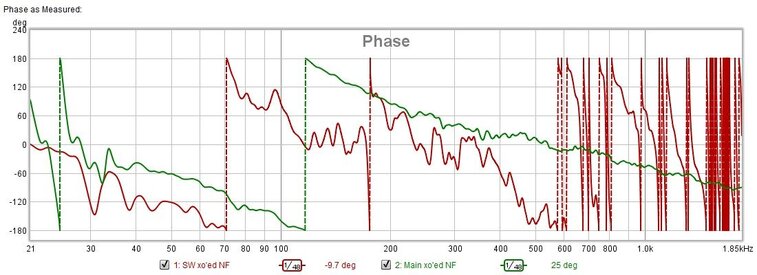
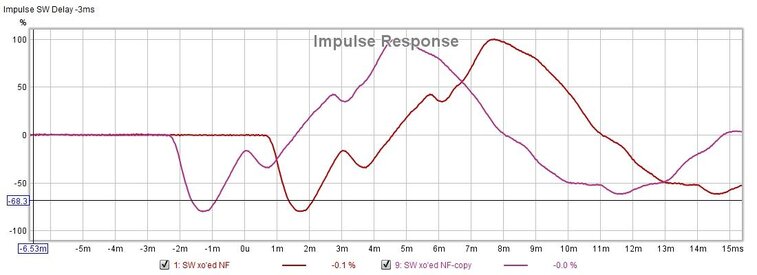
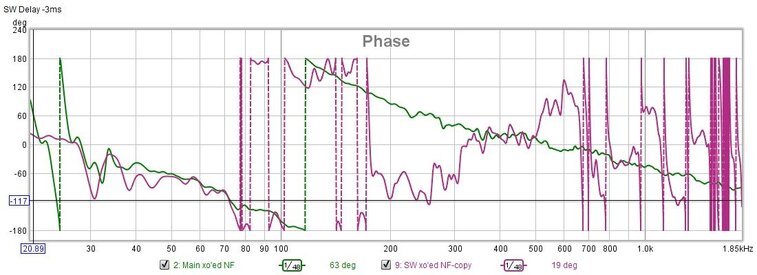
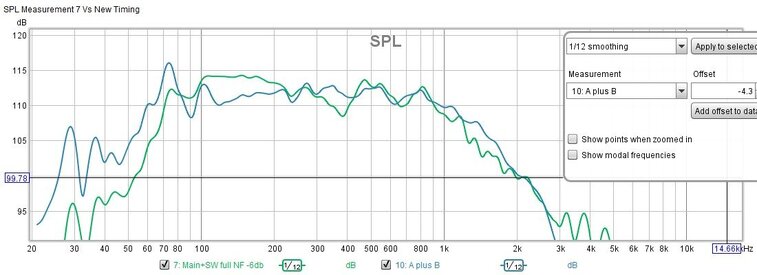
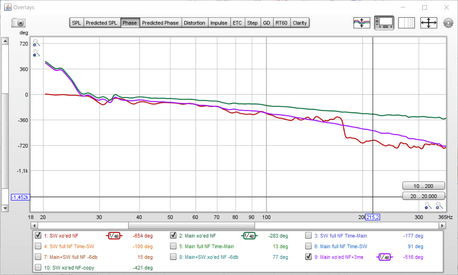
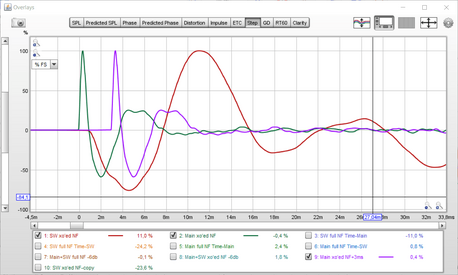
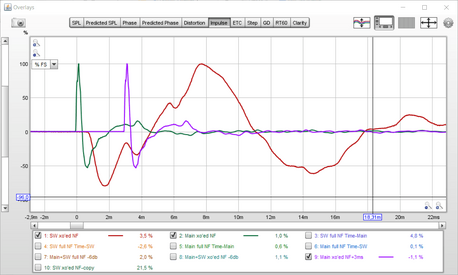
 )
)